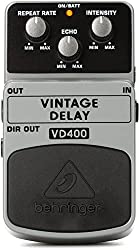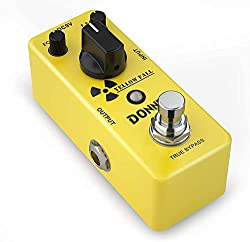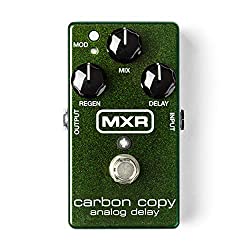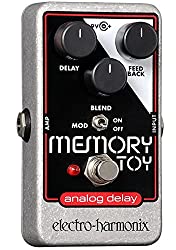Behringer Vd400 Vintage Analog Delay Pedal Review
When I play rock music, I like to create a warm vintage sound by using analog delay pedals. I used to feel unsure about which analog delay pedal to buy since there are so many on the market.
Now that I have experience with these pedals, I’m here to tell you about one of my favorites: the Behringer Vd400 Vintage Analog Delay Pedal.
Things to Consider Before Buying an Analog Delay Pedal
Depending on your preferred style of music and the effects you’re looking for, the process of finding the right analog delay pedal will be a unique one.
The Behringer Vd400 solves the classic issue of not being able to find a good analog sound for an affordable price. Although I love this pedal, there are some things you should consider before purchasing it:
- How many settings you’re looking for
- How much delay time you want
This model is pretty standard in terms of its settings and won’t provide you with modulation effects.
If you’re looking to experiments with different types of delay effects that will modulate your sound, you might want to check out the Red Panda Particle granular delay pedal.
You should also consider how much delay time you’re looking for since when it comes to analog vs. digital delay pedals, digital pedals usually win for delay time.
The Behringer Vintage Delay Review
This pedal has some great features to discuss, but first I want to review what analog delay pedals do. These pedals repeat your audio back to you and produce an echo effect.
You can adjust the pedals settings to fine tune your echo effect and make it fit well with your music.
Using delays at the end of pedal chains are an excellent way to incorporate them into a more complex sound.
If you want to learn more about pedal order, take a look at this article
Compared to other leading analog delay pedals such as the MXR M169 Carbon Copy Delay Pedal, this model is much more simple and affordable.
Pros
- Affordable
- Simple to use
- Split outputs
Cons
- No modulation effects
- Shorter delay time than other pedals
- No extra delay modes
Features of Behringer Vd400 Vintage Analog Delay Pedal
This pedal doesn’t have a large number of features, making it a good fit for beginner delay pedal users.
This pedal will give you the much coveted warm vintage sound so often associated with classic rock music.
The Behringer delay has three knobs and will allow you to split your output, sending your delay signal and direct signal down two different paths.
Repeat Rate
The Repeat Rate knob on this pedal will function the same way that a delay time knob on other pedals will.
Through this knob, you’ll be able to affect the amount of time that will pass before you hear the next repeat or echo.
By decreasing the amount of time between repeats, you can create stutter-like effects.
If you turn your Repeat Rate knob all the way to the right, you’ll have much longer periods of time between each repeat which can create the feeling of being in a large cave.
Echo
our echo will be your mix knob and will let you experiment between wetter or more dry signals.
If you’re new to the “wet and dry signal” lingo, a wet signal is one that has been affected by the pedal, and the dry signal is the natural tone.
If a signal is 100% wet, then you can expect to hear a lot of delay effects in your sound.
Intensity
Your echo knob will allow you to adjust how many repeats or echoes you hear from your delay pedal. The more repeats you hear, the more intense your delay effect will be.
If you turn this knob all the way to the left, you’ll hear one single echo. If you turn the knob to the right, you’ll hear “infinite” echoes.
More echoes create the impression of playing in a large reverberant space, such as a concert hall, while fewer echoes remind me of playing in a room with concrete walls.
If you want a “dirty” vintage effect, try turning this knob all the way up, and you’ll notice an increased muffling effect with each repeat.
Higher intensity settings will sound great if you’re strumming chords. Take a listen for yourself:
300ms Delay Time
This pedal will give you 300ms of delay time, which is significantly shorter than other digital delay pedals.
300ms of delay time will work well to produce slapback effects, but you might want to consider a pedal with more time capabilities if you want to produce U2-style effects.
For example, the Boss DD-7 will give you up to 6.4 seconds of delay time and will produce much more noticeable effects.
Reviews
I’ve scoured the internet looking for reviews, and I’m happy to say that a lot of musicians agree with me: this is a great pedal considering its affordable price. Let’s take a look at what they’re saying:
Alternatives
If you’ve decided this isn’t the right delay pedal for you, consider these alternatives:
1. Donner Yellow Fall Vintage Pure Analog Delay Pedal True Bypass
This is an excellent pedal for musicians who are on a budget and want a small pedal that won’t take up too much space on their pedalboard.
The Donner Yellow Fall pedal has 600ms of delay time, which is 300ms more than the Behringer pedal. Some musicians say that they find the knobs on this pedal too small, but it’s necessary if you’re going to have such a compact and lightweight device.
2. MXR M169 Carbon Copy Analog Delay
If you’re prepared to invest more in a higher quality, more complex analog delay pedal, then the MXR M169 is a great choice.
This pedal has 600ms of delay time, so you’ll be able to create more dramatic echo effects than with the Behringer model. This model also includes modulation effects which will mimic the sounds tape delays create.
3. Electro-Harmonix Memory Toy Analog Delay Pedal
Electro-Harmonix is another great brand name that you can rely on when buying an analog delay pedal.
This pedal has 550ms of delay time, which is slightly shorter than the Donner Yellow Fall and MXR M169 but shouldn’t make too much of a difference.
This pedal has a selectable chorus setting, which will provide some great modulation effects to bring your music to the next level.
Conclusion
Finding a great vintage analog sound while on a budget can be tough, but hopefully, this Behringer Vd400 review showed you that you don’t have to sacrifice sound quality when you’re trying to avoid breaking the bank.
This model is easy to use and has a great warm sound quality that will become more and more “dirty” as your repeats continue.





